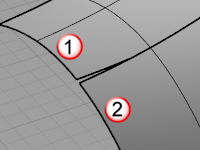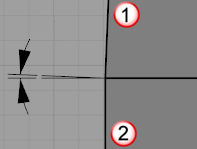Selection commands
Dedicated selection commands let you select by object properties.
Selection categories
Select object basics
To select single objects with a click
- Click an object to select it.
- Click away from the objects to deselect.
To select objects by a window rectangle
- Drag a selection rectangle from left to right to use a window selection.
Note
-
When you make a window selection, objects completely enclosed in the selection rectangle are selected.
-
To make the mouse always use either a window or crossing selection, see Mouse Options, Mouse group select.
-
Search for SelectionWindowStrokeColor and SelectionWindowFillColor in Tools > Options > Advanced to change the colors of the window selection rectangle.

See: SelWindow
To select objects by a crossing rectangle
- Drag a selection rectangle from right to left to do a crossing selection.
See: SelCrossing
Note
-
When you make a crossing selection, all objects inside or partially inside the selection rectangle are selected.
-
To make the mouse always use either a window or crossing selection, see Mouse Options, Mouse group select.
-
Search for SelectionWindowCrossingStrokeColor and SelectionWindowCrossingFillColor in Tools > Options > Advanced to change the colors of the crossing selection rectangle.

To add objects to a selection
-
Press and hold Shift while clicking single objects or using a window or crossing.
Shift +
 or
or
To remove objects from a selection
-
Press and hold Ctrl(CMD) while clicking single objects or using a window or crossing.
Ctrl(CMD) +
 or
or 
-
When two shaded objects, one behind the other, are selected, Ctrl(CMD)+clicking on the wireframe of the object behind, it gets deselected, not the object in front.
-
Selection menu
If several objects appear to be stacked in the area of the cursor and Rhino is not able to tell which one you want to select, the Selection Menu appears.
When the Selection Menu pops up, the current object and its designation in the list highlight.
To select an object
- Click the desired object name in the selection menu list with the left mouse button.
Or - Click the left mouse button at the original pick point to cycle through the object name list.
- Click the right mouse button to accept the currently-highlighted object name.
Or
- Use the mouse wheel to cycle through the list.
- Click the right mouse button to accept the currently-highlighted object name.
To cancel the selection process
- Click None.
- Click away from the objects.
- Click another object.
To configure the selection menu, see: Selection Menu Options, or right-click the Selection Menu title bar.
Select sub-parts of objects
For many commands, you can select sub-parts of objects or specified object types to allow you to restrict selection in a tight area.
Examples include:
- Curve and surface control points
- Polysurface and extrusion faces and edge curves
- Surface edge curves
- Mesh vertices, faces, boundaries, and edges
- SubD points, faces, boundaries and edges.
- Objects and sub-objects within a group
- Polycurve and polyline segments
- Surface, polysurfaces, and extrusion object vertices. These are the equivalent of the points enabled by SolidPtOn.
- Whole objects in block instances.
Selecting sub-objects with a mouse
You can select sub-objects with a mouse before a command starts (pre-select) or during a command (post-select).
To select sub-object parts with a mouse
-
Press and hold Ctrl(CMD) + Shift and left mouse click, window, or crossing.
Ctrl(CMD) + Shift +
 or
or 
To de-select sub object parts with a mouse
-
Press and hold Ctrl(CMD) and left mouse click, window, or crossing.
Ctrl(CMD) +
 Or
Or 
Restrictions for blocks:
- Only whole objects in blocks can be selected.
For example, you can select a box in a block, but you cannot select its faces or edges. - Whole objects and sub-objects in nested blocks cannot be selected.
Select sub-parts with a command-line filter
Command-line selection filters work on a more limited set of sub-objects for commands that ask you to select objects after the command starts (post-select). These commands let you use filters to pick a sub-part of an object or specific objects rather than the whole object.
To select a sub-part of an object as input to a command, type
Sub-object parts can be selected and de-selected using capture tools: SelWindow and SelCrossing, Lasso, SelBrush, SelCircular, SelBoundary, SelVolumeSphere, and SelBox.
Pre-select/Post-select
For commands that require object input, the objects can be selected before or after the command starts. Command prompts or options may be slightly different in the two methods. When objects are pre-selected the possibilities include:
- The command determines that the objects can be used and proceeds without further prompting.
- The command may proceed, but the result may be unexpected.
- The command cannot determine which objects are to be used and the pre-selected objects are unselected, and you are prompted to select specific objects again.
- Options may not appear at the command prompt.
| Toolbar | Menu |
|---|---|
|
|
|
The Select command selects objects.
Steps
- Click an object to select it.
| Toolbar | Menu | Shortcut |
|---|---|---|
|
|
Edit Select Objects > All Objects |
Ctrl (CMD) + A |
The SelAll command selects all objects.
| Toolbar | Menu | Shortcut |
|---|---|---|
|
|
Edit Select Objects > None |
Esc |
The SelNone command deselects all objects.
The SelNone command does not run inside a command to clear pre-selected objects.
| Toolbar | Menu | Shortcut |
|---|---|---|
|
|
|
C |
The SelCrossing command selects with a crossing window.
Steps
- Drag a selection rectangle enclosing or crossing objects.
|
Toolbar |
Menu |
|---|---|
|
|
Edit Select Objects > Area and Volume Select > Rectangular |
The SelRectangular command emulates the regular window selection action with some control options.
Steps
-
Start the command.
-
Select command-line options.
-
Draw a selection rectangle in a viewport.
Command-line options
SelectionMode
Window
Selects objects completely inside the selection region.
Crossing
Selects objects completely or partially inside the selection region.
InvertWindow
Selects objects completely outside the selection region.
InvertCrossing
Selects objects completely or partially outside the selection region.
SelectThroughObjects
Specifies whether the objects or sub-objects occluded (not visible) behind others can be selected.
| Toolbar | Menu | Alias |
|---|---|---|
|
|
|
W |
The SelWindow command selects with an enclosing window.
Steps
- Drag a selection rectangle enclosing objects.
| Toolbar | Menu |
|---|---|
|
|
Edit Select Objects > Invert |
The Invert command deselects all selected objects and selects all visible objects that were not previously selected.
| Toolbar | Menu |
|---|---|
|
|
Analyze Diagnostics > Select Bad Objects |
The SelBadObjects command selects all objects that do not pass Check.
Delete or rebuild the object.
| Toolbar | Menu |
|---|---|
|
|
Edit Select Objects > Visible Surfaces and Meshes |
The SelVisible command selects all surfaces or meshes that are in front of other objects in the active viewport with a crossing selection.
Steps
- Drag a crossing selection.
Note: The SelVisible command does not work with block instances since they are drawn using their own draw lists that have no relationship with other objects in the model.
| Toolbar | Menu |
|---|---|
|
|
Edit Select Objects > Area and Volume Select > Small Objects |
The SelSmall command selects all objects smaller than the specified size.
| Toolbar | Menu |
|---|---|
|
|
Edit Select Objects Area and Volume Select Lasso Control Points > Select Control Points > Lasso |
The Lasso command selects objects by sketching an irregular shape around them.
The lasso uses the Tracking lines color set in Color Options.
Command-line options
SelectionMode
Window
Selects objects completely inside the lasso path.
Crossing
Selects objects crossed by or completely inside the lasso path.
InvertWindow
Selects objects completely outside the lasso path.
InvertCrossing
Selects objects crossed by or completely outside the lasso path.
SelectThroughObjects
Specifies whether the objects or sub-objects occluded (not visible) behind others can be selected.
Undo
Removes the last point of the lasso path.
Note
-
Objects outside the viewport boundaries but within the boundaries of the selection object can be selected.
-
The view can be panned during the selection to bring more objects into view.
-
Use the CullControlPolygon command to hide control points and mesh vertices behind objects.
-
Use Selection Filters to change what types of objects/sub-objects are selectable.
| Toolbar | Menu |
|---|---|
|
|
Edit Select Objects > Area and Volume Select > Boundary |
The SelBoundary command selects objects with a view based boundary defined by a closed curve.
Command-line options
SelectionMode
Window
Selects objects completely inside the boundary curve.
Crossing
Selects objects completely or partially inside the boundary curve.
InvertWindow
Selects objects completely outside the boundary curve.
InvertCrossing
Selects objects completely or partially outside the boundary curve.
Precise
Yes
The selection wire boundary is used as the boundary.
The testing is done in double-precision floating point in screen space. If any part of the object is even slightly outside the selection boundary, it will not be included.
No
A selection mask bitmap is built from the boundary, and the objects are tested against that mask.
The testing is done using a bitmap selection mask, which effectively adds an average of half a pixel wide fuzz zone around the selection boundary. Objects that visually seem as though they should be included, but are actually partially outside the boundary, are still included.
| Toolbar | Menu |
|---|---|
|
|
Edit Select Objects > Area and Volume Select > Brush |
The SelBrush command selects objects based on painting a thick brush stroke.
Steps
-
Click and drag or click repeatedly to draw the stroke.
By default it uses crossing select: objects touched by the stroke are selected.
Use Selection Filters to change what types of objects/sub-objects are selectable.
Command-line options
Curve
Select an existing curve that represents the brush stroke.
Polyline
YesDraw straight stroke between clicks. |
NoDraw strokes by freehand. |
SelectionMode
Window
Selects objects completely inside the brush stroke.
Crossing
Selects objects completely or partially inside the brush stroke.
InvertWindow
Selects objects completely outside the brush stroke.
InvertCrossing
Selects objects completely or partially outside the brush stroke.
BrushWidth
Specifies the brush width in pixels.
Or, hold Shift and move the cursor up (increase size) or down (decrease size) to change the brush size dynamically.
SelectThroughObjects
Specifies whether the objects or sub-objects occluded (not visible) behind others can be selected.
RealTimeSelection
Yes
Select instantly when the brush circle touches objects. Brush strokes do not display.
- Hold Ctrl(CMD) to deselect objects.
- Hold Ctrl(CMD) + Shift to select sub-objects.
No
Select objects under strokes when the command ends.
| Toolbar | Menu |
|---|---|
|
|
Edit Control Points > Select Control Points > Brush |
The SelBrushPoints command selects points, control points, and points within a point cloud with a drag of the mouse to simulate a brush stroke.
To unselect, press Ctrl while brushing selected points.
Command-line options
BrushWidth
Specifies the brush width in pixels.
| Toolbar | Menu |
|---|---|
|
|
|
The SelFence command selects objects based on drawing a line through objects. Only objects crossed by the line are selected.
Command-line option
Curve
Select an existing curve as the selector.
| Toolbar | Menu |
|---|---|
|
|
Edit Select Objects > Area and Volume Select > Circular |
The SelCircular command draws a circle on the view plane to select objects.
SelectionMode
Window
Selects objects completely inside the circle.
Crossing
Selects objects completely or partially inside the circle.
InvertWindow
Selects objects completely outside the circle.
InvertCrossing
Selects objects completely or partially outside the circle.
| Toolbar | Menu |
|---|---|
|
|
Edit Select Objects > Area and Volume Select > Box |
The SelBox commands selects objects with point samples inside/outside/crossing a box-shaped volume.
It will not select objects that should not be included, but may miss an object if the point samples miss the selection box.
SelectionMode
Window
Selects objects completely inside the box.
Crossing
Selects objects completely or partially inside the box.
InvertWindow
Selects objects completely outside the box.
InvertCrossing
Selects objects completely or partially outside the box.
| Toolbar | Menu |
|---|---|
|
|
Edit Select Objects > Area and Volume Select > Pipe |
The SelVolumePipe command selects objects inside, outside, or crossing a pipe-shaped volume.
SelectionMode
Window
Selects objects completely inside the pipe.
Crossing
Selects objects completely or partially inside the pipe.
InvertWindow
Selects objects completely outside the pipe.
InvertCrossing
Selects objects completely or partially outside the pipe.
| Toolbar | Menu |
|---|---|
|
|
Edit Select Objects > Area and Volume Select > Sphere |
The SelVolumeSphere command selects objects inside, outside, or crossing a spherical volume.
Command-line options
SelectionMode
Window
Selects objects completely inside the sphere.
Crossing
Selects objects completely or partially inside the sphere.
InvertWindow
Selects objects completely outside the sphere.
InvertCrossing
Selects objects completely or partially outside the sphere.
| Toolbar | Menu |
|---|---|
|
|
|
The SelVolumeObject command selects objects inside, outside, or crossing an closed extrusion object, surface, polysurface, or mesh.
Command-line options
SelectionMode
Window
Selects objects completely inside the selection object.
Crossing
Selects objects completely or partially inside the selection object.
InvertWindow
Selects objects completely outside the selection object.
InvertCrossing
Selects objects completely or partially outside the selection object.
| Toolbar | Menu |
|---|---|
|
|
Edit Select by Object Property > By Annotation Style |
The SelAnnotationStyle command selects annotation objects based on their style.
| Toolbar | Menu |
|---|---|
|
|
Edit Select Objects > Dimensions |
The SelDim command selects all dimensions.
| Toolbar | Menu |
|---|---|
|
|
Edit Select Objects > Dimensions with Style Override |
The SelDimOverride command selects dimension objects that have style settings changed and different from the associated annotation styles.
-
Dimension text change is ignored.
-
The Fit text setting is ignored.
See also
SelDimTextOverride
Selects dimension objects with non-default dimension text.
|
Toolbar |
Menu |
|---|---|
|
|
Edit Select Objects > Dimensions with Text Override |
The SelDimTextOverride command selects dimension objects with non-default dimension text.
See also
SelDimOverride
Selects dimension objects that have style settings changed and different from the associated annotation styles.
| Toolbar | Menu |
|---|---|
|
|
|
The SelDot command selects all annotation dots.
|
Toolbar |
Menu |
|---|---|
|
|
Edit Select by Object Property > By Annotation Font |
The SelFontUse command selects annotations by fonts.
Steps
-
Start the command.
A dialog lists the fonts used by annotations (which are not locked, hidden, selected, or in blocks) in the current model or layout space.
-
Select a font in the list.
Hold Shift or Ctrl(CMD) to select more fonts.
| Toolbar | Menu |
|---|---|
|
|
Edit Select Objects > Leaders |
The SelLeader command selects all leaders.
| Toolbar | Menu |
|---|---|
|
|
Edit Select Objects > Text |
The SelText command selects all text.
|
Toolbar |
Menu |
|---|---|
|
|
Edit Dimension Types > Angular Dimensions |
The SelDimAngular command selects all angular dimension objects.
|
Toolbar |
Menu |
|---|---|
|
|
Edit Dimension Types > Centermarks |
The SelDimCentermark command selects all center mark dimension objects.
|
Toolbar |
Menu |
|---|---|
|
|
Edit Dimension Types > Linear Dimensions |
The SelDimLinear command selects all linear dimension objects.
|
Toolbar |
Menu |
|---|---|
|
|
Edit Dimension Types > Ordinate Dimensions |
The SelDimOrdinate command selects all ordinate dimension objects.
| Toolbar | Menu |
|---|---|
|
|
Edit Control Points > Select Control Points > Add Next U |
The AddNextU command adds the control point in the positive u direction to the selection.
| Toolbar | Menu |
|---|---|
|
|
Edit Control Points > Select Control Points > Add Next V |
The AddNextV command adds the control point in the positive v direction to the selection.
| Toolbar | Menu |
|---|---|
|
|
Edit Control Points > Select Control Points > Add Previous U |
The AddPrevU command adds the control point in the negative u direction to the selection.
| Toolbar | Menu |
|---|---|
|
|
Edit Control Points > Select Control Points > Add Previous V |
The AddPrevV command adds the control point in the negative v direction to the selection.
| Toolbar | Menu |
|---|---|
|
|
Edit Control Points > Select Control Points > Next U |
The NextU command selects the control point in the positive u direction.
| Toolbar | Menu |
|---|---|
|
|
Edit Control Points > Select Control Points > Next V |
The NextV command selects the control point in the positive v direction.
| Toolbar | Menu |
|---|---|
|
|
Edit Control Points > Select Control Points > Previous U |
The PrevU command selects the control point in the negative u direction.
| Toolbar | Menu |
|---|---|
|
|
Edit Control Points > Select Control Points > Previous V |
The PrevV command selects the control point in the negative v direction.
| Toolbar | Menu |
|---|---|
|
|
|
The SelControlPoint command selects all control points on a curve or surface.
| Toolbar | Menu |
|---|---|
|
|
|
The SelControlPointRegion command selects a range of control points on a curve or surface.
Note
- If curve or surface control points are pre-selected, the command expands the selection to cover all control points between the limits set by the selected control points.
- If nothing is selected, the command asks to select a curve or surface, and then asks for two points that define a region of control points to select.
| Toolbar | Menu |
|---|---|
|
|
Edit Control Points > Select Control Points > Connected |
The SelConnected command selects adjacent control points of a curve, surface, mesh, or SubD.
It also selects adjacent SubD surface points (turned on by EditPtOn ).
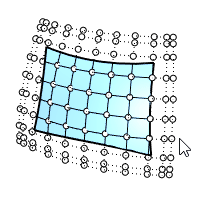
| Toolbar | Menu |
|---|---|
|
|
Edit Control Points > Select Control Points > Select U |
The SelU command selects all control points in the u direction.
Note:
When Make control polygon pickable is enabled, double-clicking a control polygon selects all control points in the row. Hold down Ctrl(CMD) and double-click to deselect a row of control points in selection.
| Toolbar | Menu |
|---|---|
|
|
Edit Control Points > Select Control Points > Select UV |
The SelUV command selects all control points in the u and v directions.
Note:
When Make control polygon pickable is enabled, double-clicking a control polygon selects all control points in the row. Hold down Ctrl(CMD) and double-click to deselect a row of control points in selection.
| Toolbar | Menu |
|---|---|
|
|
Edit Control Points > Select Control Points > Select V |
The SelV command selects all control points in the v direction.
| Toolbar | Menu |
|---|---|
|
|
Edit Select Objects > Clipping Planes |
The SelClippingPlane command selects all clipping planes.
|
Toolbar |
Menu |
|---|---|
|
New in V8
|
Edit Select Objects > Clipping Planes in Viewport |
The SelClippingPlaneInViewport command selects the clipping planes that clip the current model or detail viewport.
Steps
- Select a model viewport or enable a detail view in a layout.
- Run the command.
|
Toolbar |
Menu |
|---|---|
|
|
|
The SelDetail command selects all Detail view rectangles in the current Layout viewport.
| Toolbar | Menu |
|---|---|
|
|
Edit Select Objects > Extrusions |
The SelExtrusion command selects all objects created as light-weight extrusions.
| Toolbar | Menu |
|---|---|
|
|
Edit Select Objects > Hatches |
The SelHatch command selects hatch objects.
|
Toolbar |
Menu |
|---|---|
|
|
The SelHatchPattern command selects hatch objects by hatch patterns.
Options
 Search pattern name
Search pattern name
Type a text string to list only the patterns that contain the text string in their names.
+/- Selection column
The selected state of the patterns.
-
Click the +/- header to select or deselect all patterns.
Name
Names of the patterns currently used in the model.
-
Click the Name header to sort the list in ascending or descending alphabetical order.
-
Click the Name or Selection column to select a pattern. Hold Ctrl (CMD) or Shift key to make a non-continuous or range selection.
Pattern
The visual preview of each pattern.
Select patterns by picking hatch objects in viewports.
| Toolbar | Menu |
|---|---|
|
|
Edit Select Objects > Lights |
The SelLight command selects all lights.
| Toolbar | Menu |
|---|---|
|
|
|
The SelMappingWidget command selects all texture mapping widgets.
| Toolbar | Menu |
|---|---|
|
|
|
The SelNamedViewWidget command selects all named view widget objects.
| Toolbar | Menu |
|---|---|
|
|
|
The SelPicture command selects all objects created with the Picture command.
| Toolbar | Menu |
|---|---|
|
|
Edit Select Objects > Curves |
The SelCrv command selects all curves.
| Toolbar | Menu |
|---|---|
|
|
|
The SelShortCrv command selects all curves less than a specified length.
| Toolbar | Menu |
|---|---|
|
|
|
The SelOpenCrv command selects all open curves.
| Toolbar | Menu |
|---|---|
|
|
|
The SelPlanarCrv command selects all planar curves.
| Toolbar | Menu |
|---|---|
|
|
|
The SelClosedCrv command selects all closed curves.
| Toolbar | Menu |
|---|---|
|
|
Edit Select Objects > Chain |
The SelChain command selects curve or surface edges that touch end-to-end.
To chain-select objects
-
Inside a command that accepts chain selection, type chain.
-
Select first chain segment.
Chain selection prefers segments of the same type (curve or edge) as the first picked segment.
| Chain options | |
|---|---|
|
ChainContinuity |
Controls the level of continuity required between segments to be selected. Tip: You can double-click or Ctrl (CMD) + double-click on a curve to select or deselect all the curves connected with tangent continuity. |
|
Direction |
ForwardSelects curves in the positive curve direction. BackwardSelects curves in the negative curve direction. BothSelects curves in both the positive and negative curve direction. |
|
GapTolerance |
If the gap between two edges/curves is less than this value, the chain selection will ignore the gap and will select the next segment. |
|
AngleTolerance |
When Continuity is set to Tangency, if the angle between two edges/curves is less than this value, the chain selection will consider the criteria for continuity met and will select the next segment. |
|
Undo |
Undo last segment selection. |
|
Next |
Select next segment. |
|
All |
Select all segments. |
| Toolbar | Menu |
|---|---|
|
|
Edit Select Objects > Lines |
The SelLine command selects all lines and straight, higher degree curves. For example, a straight degree three curve with four points will be selected, but a degree three curve with five or more points will not be selected.
| Toolbar | Menu |
|---|---|
|
|
Edit Select Objects > Polylines |
The SelPolyline command selects all polylines.
|
Toolbar |
Menu |
|---|---|
|
|
Edit Select Objects > Self‑Intersecting Curves |
The SelSelfIntersectingCrv command selects the curves that pass through themselves.
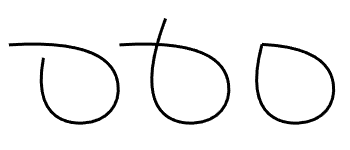
See also
IntersectSelf
Finds self-intersections or self-overlaps in curves and marks them with point objects or curve segments.
| Toolbar | Menu |
|---|---|
|
|
|
The SelClosedMesh command selects all closed mesh objects.
| Toolbar | Menu |
|---|---|
|
|
|
The SelEdgeLoop command selects a loop of mesh/SubD edges by picking an edge in the loop.
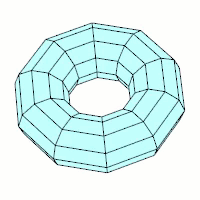
Steps
-
Pick a mesh/SubD edge.
The picked edge is highlighted brighter than the rest of edges in the loop.
You can hold down Ctrl(CMD) and pick the brighter edge to deselect the loop.
- Press Enter to accept the selection.
An edge loop is selected. -
Hold down Shift + Ctrl(CMD) and pick the edges to deselect individually.
- This command only works on meshes with UV information.
- This command can be used when a command prompts for selecting mesh/SubD edges.
The SelEdgeRing command selects a ring of mesh/SubD edges by picking an edge in the ring.
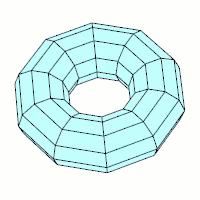
Steps
-
Pick a mesh/SubD edge.
The picked edge is highlighted brighter than the rest edges in the ring.
You can hold down Ctrl(CMD) and pick the brighter edge to deselect the ring.
- Press Enter to accept the selection.
An edge ring is selected. -
Hold down Shift + Ctrl(CMD) and pick the edges to deselect individually.
- This command only works on meshes with UV information.
- This command can be used when a command prompts for selecting mesh/SubD edges.
| Toolbar | Menu |
|---|---|
|
|
|
The SelFaceLoop command selects a loop of mesh/SubD faces by picking an edge between any two faces in the loop.
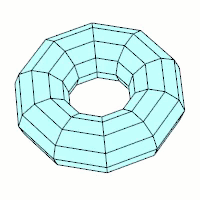
Steps
-
Pick a mesh/SubD edge.
The picked edge is highlighted brighter than the rest edges in the loop.
You can hold down Ctrl(CMD) and pick the brighter edge to deselect the loop.
- Press Enter to accept the selection.
A face loop is selected. -
Hold down Shift + Ctrl(CMD) and pick the faces to deselect individually.
- This command only works on meshes with UV information.
- This command can be used when a command prompts for selecting mesh/SubD faces.
| Toolbar | Menu |
|---|---|
|
|
Edit Select Objects > Polygon Meshes |
The SelMesh command selects all mesh objects.
| Toolbar | Menu |
|---|---|
|
|
|
The SelNakedMeshEdgePt command selects unwelded vertices on polygon mesh edges.
Note
- Polygon mesh vertices are not completely surrounded by faces are displayed.
- Joined meshes, such as those made by the MeshBox command, have naked mesh edge points where the sub-meshes are joined.
- To eliminate naked mesh edge points, match them in pairs, and then use the Weld command to make a single mesh that cannot be exploded. Edges that formerly rendered sharp will shade rounded, unless you use the FlatShade command.
| Command-line options | |
|---|---|
|
IncludeUnweldedEdges |
The IncludeUnweldedEdges option determines whether points on edges that are unjoined or only naked edge vertices will be included. This is good for troubleshooting MatchMeshEdge. |
| Toolbar | Menu |
|---|---|
|
|
|
The SelOpenMesh command selects all open mesh objects.
| Toolbar | Menu |
|---|---|
|
|
|
The SelClosedSubD command selects all closed subdivision objects.
| Toolbar | Menu |
|---|---|
|
|
|
The SelOpenSubD command selects all open subdivision objects.
| Toolbar | Menu |
|---|---|
|
|
|
The SelSubD command selects all subdivision objects.
SelSubDFriendlyCrv
| Toolbar | Menu |
|---|---|
|
|
Edit Select Objects > SubD Friendly Curves |
The SelSubDFriendlyCrv command selects SubD friendly (compatible) curves.

- SubD friendly curves are degree 3 uniform curves that have the second point on both ends locked. The first and last three control points are always collinear.
| Toolbar | Menu |
|---|---|
|
|
Edit Control Points > Select Control Points > Invert |
The InvertPt command deselects all selected control or edit points and selects all visible control or edit points that were not previously selected.
| Toolbar | Menu |
|---|---|
|
|
Edit Select Objects > Points |
The SelPt command selects all point objects.
| Toolbar | Menu |
|---|---|
|
|
|
The SelPtCloud command selects all point cloud objects.
| Toolbar | Menu | Alias |
|---|---|---|
|
|
Edit Select Objects > Polysurfaces |
SelPolysurface |
The SelPolysrf command selects all polysurfaces.
| Toolbar | Menu |
|---|---|
|
|
|
The SelClosedPolysrf command selects all closed polysurfaces.
| Toolbar | Menu |
|---|---|
|
|
|
The SelOpenPolysrf command selects all open polysurfaces.
| Toolbar | Menu |
|---|---|
|
|
|
The SelNonManifold command selects non-manifold polysurfaces and meshes.
| Toolbar | Menu |
|---|---|
|
|
Edit Select Objects > Surfaces |
The SelSrf command selects all surfaces.
| Toolbar | Menu |
|---|---|
|
|
|
The SelClosedSrf command select all closed surfaces.
| Toolbar | Menu |
|---|---|
|
|
|
The SelOpenSrf command selects all open surfaces.
| Toolbar | Menu |
|---|---|
|
|
|
The SelPlanarSrf command selects all planar surfaces.
| Toolbar | Menu |
|---|---|
|
|
|
The SelTrimmedSrf command selects all trimmed surfaces.
| Toolbar | Menu |
|---|---|
|
|
|
The SelUntrimmedSrf command selects all untrimmed surfaces.
| Toolbar | Menu |
|---|---|
|
|
Edit Select by Object Property > By Color |
The SelColor command selects all objects of a specified display color or material diffuse color depending on the display mode of the active viewport.
- In a display mode that shows materials, the SelColor command selects objects by material diffuse colors.
- Objects enclosed in block instances or groups are not selected.
|
Command-line options |
|
|---|---|
|
Color |
Select a color from the Select Color dialog box. |
|
RGBA |
Select color using red, green, blue, alpha values. |
| Toolbar | Menu |
|---|---|
|
|
|
The SelID command selects objects by object ID number.
| Toolbar | Menu |
|---|---|
|
|
|
The SelLinetype command selects objects with the specified linetype.
| Toolbar | Menu |
|---|---|
|
|
|
The SelMaterialName command selects objects/sub-objects with the same render material name assigned by object or by layer.
Options
 Select all
Select all
Selects all items listed in the dialog.
 Select none
Select none
Clears the current selection in the list.
 Invert selection
Invert selection
Selects all unselected items and deselects the currently selected ones.
 Copy names to clipboard
Copy names to clipboard
Copies the names of selected items to the clipboard as text.
 Search box
Search box
Filters the list to show only items that contain the entered text.
<No material>
Selects all objects that don't have a material assigned.
The number of selected objects is reported in the command window.
Steps
- Click in the dialog box to select objects or sub-objects with the material assigned.
-
Enable the Sub-objects filter to list per-face materials in the dialog.
| Toolbar | Menu |
|---|---|
|
|
Edit Select by Object Property > By Object Name |
The SelName command selects objects by name.
Steps
-
Choose from the list or click to select an object with the target name.
-
Select names directly from the list, or use the buttons to perform selecting actions.
Hold Ctrl (Cmd on Mac) to add or remove individual items, or Shift key to select a range.
Options
 Select all
Select all
Selects all items listed in the dialog.
 Select none
Select none
Clears the current selection in the list.
 Invert selection
Invert selection
Selects all unselected items and deselects the currently selected ones.
 Copy names to clipboard
Copy names to clipboard
Copies the names of selected items to the clipboard as text.
 Search box
Search box
Filters the list to show only items that contain the entered text.
<No name>
Selects all objects that don't have a name.
The number of selected objects is reported in the command window.
Use of scriptable command, -SelName
-
The scriptable command works with pre-pick and allows using wildcard character ? (question mark) and * (asterisk) for matching text strings. Details...
| Toolbar | Menu |
|---|---|
|
|
|
The SelRenderColor command selects objects by their (diffuse) render color. Objects enclosed in block instances are not selected. Objects enclosed in groups are selected.
| Command-line options | |
|---|---|
|
Color |
Select a color from the Select Color dialog box. |
|
RGB |
Select color using red, green, blue values. |
| Toolbar | Menu |
|---|---|
|
|
|
The SelKey command selects objects by their user attribute key.
-
Wildcard character ? (question mark), * (asterisk), and ~ (tilde) can be used for matching text strings. Details...
| Toolbar | Menu |
|---|---|
|
|
|
The SelValue command selects objects by their user attribute value.
-
Wildcard character ? (question mark), * (asterisk), and ~ (tilde) can be used for matching text strings. Details...
| Toolbar | Menu |
|---|---|
|
|
|
The SelKeyValue command selects objects by their user attribute key and value.
-
Wildcard character ? (question mark), * (asterisk), and ~ (tilde) can be used for matching text strings. Details...
| Toolbar | Menu |
|---|---|
|
|
Edit Select Objects > Blocks Block Instances |
The SelBlockInstance command selects all block instances.
| Toolbar | Menu |
|---|---|
|
|
Edit Select by Object Property > By Block Name |
The SelBlockInstanceNamed command selects all block instances of a specified name.
-
Pre-selected blocks will be highlighted in the list.
Options
 Select all
Select all
Selects all items listed in the dialog.
 Select none
Select none
Clears the current selection in the list.
 Invert selection
Invert selection
Selects all unselected items and deselects the currently selected ones.
 Copy names to clipboard
Copy names to clipboard
Copies the names of selected items to the clipboard as text.
 Search box
Search box
Filters the list to show only items that contain the entered text.
 Preview
Preview
Displays the screen capture for the selected block instance.
The number of selected block instance is reported in the command window.
|
Toolbar |
Menu |
|---|---|
|
|
Edit Select Objects > Blocks Mirrored Block Instances |
The SelMirroredBlocks command selects the block instances that were mirrored or scaled with a negative factor.
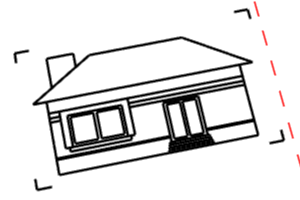
- Block instances being mirrored even times are seen as not mirrored.
| Toolbar | Menu |
|---|---|
|
|
Edit Select by Object Property > By Group Name |
The SelGroup command selects groups by name.
Options
 Select all
Select all
Selects all items listed in the dialog.
 Select none
Select none
Clears the current selection in the list.
 Invert selection
Invert selection
Selects all unselected items and deselects the currently selected ones.
 Copy names to clipboard
Copy names to clipboard
Copies the names of selected items to the clipboard as text.
 Search box
Search box
Filters the list to show only items that contain the entered text.
<No name>
Selects all groups that don't have a name.
Group names are assigned with the SetGroupName command, not in object properties.
The number of selected groups is reported in the command window.
| Toolbar | Menu |
|---|---|
|
|
Edit Select by Object Property > By Layer |
The SelLayer command selects all objects on a layer.
Steps
- Click in the dialog box to select an object on the layer.
| Command-line options | |
|---|---|
|
Select |
Allows selecting an object in the model to specify the layer. |
Use the scriptable command: -SelLayer
-
Separate sublayer names from parent names with double colons (::).
-SelLayer LayerA::Layer01
-
Wildcard character * (asterisk) and ? (question mark) are supported.
-SelLayer *
-SelLayer LayerA::*
-SelLayer Layer?01
-
If the layer names contain spaces, surround the names with double-quotes.
-SelLayer "Layer 01"
| Toolbar | Menu |
|---|---|
|
|
|
The SelLayerNumber command selects objects by layer number.
Note
- The number of the first layer is zero.
- Each layer has a number that is assigned to it for a Rhino editing session.
- The numbers may change when the model is closed and then reopened.
- This number has nothing to do with the order the layers appear in the layer dialog box.
- Deleted layers keep their number.
| Toolbar | Menu |
|---|---|
|
|
|
The SelCaptives command selects captive objects set up using the CageEdit command.
| Toolbar | Menu |
|---|---|
|
|
|
The SelControls command selects cage control objects set up using the CageEdit command.
| Toolbar | Menu |
|---|---|
|
|
Edit Select Objects > History > Objects with History |
The SelObjectsWithHistory command selects objects that have history.
| Toolbar | Menu |
|---|---|
|
|
Edit Select Objects > History > Children |
The SelChildren command selects child objects of the currently selected objects.
Command-line options
(These options are not visible with pre-selection.)
All
If no objects are selected, the All option will select all child objects.
DeselectOthersBeforeSelect
Yes
Remove the current object from selection when its child object is added.
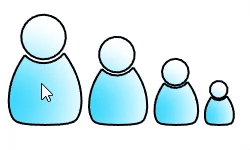
No
Keep the current object in selection when its child object is added.
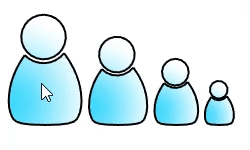
IgnoreAnnotations
Do not select annotation objects created with History recorded.
MakeChildrenSelectable
Selects history children that are hidden or locked. If they are on locked or hidden layers, those layers will be unlocked or made visible.
| Toolbar | Menu |
|---|---|
|
|
Edit Select Objects > History > Parents |
The SelParents command selects parent objects of the currently selected objects.
Command-line options
(These options are not visible with pre-selection.)
All
If no objects are selected, the All option will select all parent objects.
DeselectOthersBeforeSelect
Yes
Remove the current object from selection when its parent object is added.
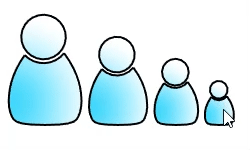
No
Keep the current object in selection when its parent object is added.
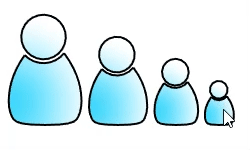
MakeParentsSelectable
Selects history parents that are hidden or locked. If they are on locked or hidden layers, those layers will be unlocked or made visible.
| Toolbar | Menu |
|---|---|
|
|
Edit Select Objects > Last Created Objects |
The SelLast command selects the last changed objects, including importing objects.
To access hidden command-line options
- Type a hyphen in front of the command name: -SelLast.
| Command-line options | |
|---|---|
|
DeselectOthersBeforeSelect |
Deselect currently selected objects before selecting the last changed objects. |
| Toolbar | Menu |
|---|---|
|
|
Edit Select Objects > Previous Selection |
The SelPrev command re-selects the previous selection set of objects or sub-objects.
To access hidden command-line options
- Type a hyphen in front of the command name: -SelPrev.
| Command-line options | |
|---|---|
|
DeselectOthersBeforeSelect |
Deselect currently selected objects before selecting the previous objects. |
| Toolbar | Menu |
|---|---|
|
|
Edit Select Objects > Duplicate Objects |
The SelDup command selects objects that are geometrically identical with another object, visible, and in the same location regardless of other object properties.
| Toolbar | Menu |
|---|---|
|
|
|
The SelDupAll command selects all visible objects that are geometrically identical, including the original.
Since this command selects both the copies and the originals, it lets you find objects that have been changed by comparing a before and after version of the model.
Compare to the SelDup command, which selects all visible objects that are geometrically identical, excluding the original.
See also
Edit objects using control points.
|
Toolbar |
Menu |
|---|---|
|
|
|
The SubDFaceEdgeVertexToggle command toggles SubD sub-object selection between SubD faces, edges, and vertices.
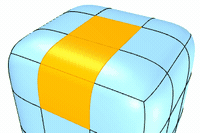
-
Assign the command to a keyboard shortcut, or an alias for convenience.
Steps
-
Ctrl(CMD)+Shift+Click one or more SubD faces.
-
Run the SubDFaceEdgeVertexToggle command several times.
The selection cycles through faces, edges, and vertices.

